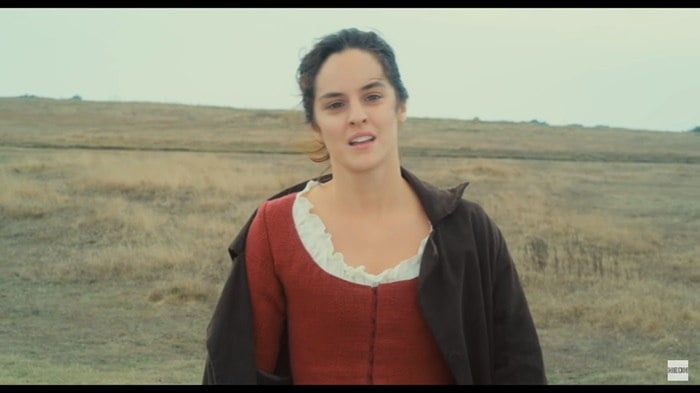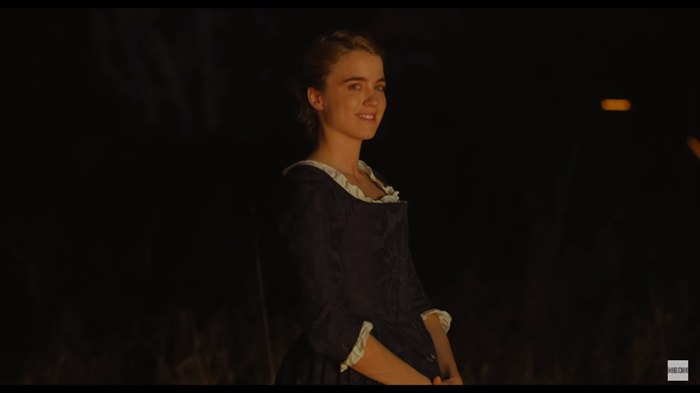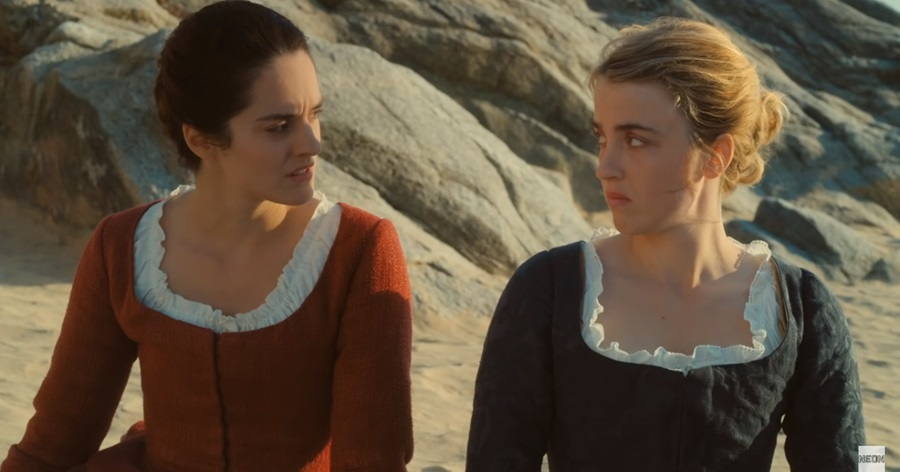Portrait of a Lady on Fire is a French film directed by Céline Sciamma, released in 2019. The movie is set in 18th-century Brittany, France, and it revolves around the complex and passionate relationship between two women, Marianne and Héloïse.
Plot Summary
Portrait of a Lady on Fire begins with Marianne (played by Noémie Merlant), an artist, arriving on a remote island. She has been commissioned to paint a portrait of Héloïse (played by Adèle Haenel), a young woman who has just left a convent and is soon to be married. However, Héloïse is reluctant to have her portrait painted, as it is intended for her prospective husband, and she resents the idea of being forced into a marriage.

Marianne, therefore, pretends to be a companion and observes Héloïse discreetly during the day to capture her likeness. The two women gradually form a connection as Marianne navigates the challenges of capturing Héloïse's essence while keeping the true purpose of her presence a secret. The artistic process becomes a medium for their emotional exchange, and their relationship deepens as they spend time together.
As the days go by, Marianne and Héloïse's connection transforms into a forbidden romance. The island's isolation and the absence of societal norms create a space for them to explore their desires and develop a profound emotional bond. The film beautifully captures the nuances of their evolving relationship, framed against the backdrop of the stunning coastal landscapes of Brittany.
The tension in the narrative arises from the impending departure of Héloïse, who is bound by societal expectations to fulfill her role as a wife. The inevitability of their separation looms over the film, adding a layer of melancholy to the blossoming love between the two women.
One significant aspect of the story is the inclusion of the character Sophie (played by Luàna Bajrami), the maid who accompanies Marianne and Héloïse. Sophie, too, has her own challenges, and her presence contributes to the exploration of class differences and the limited options available to women in that historical context.
Climax
As Marianne completes the portrait, the emotional weight of their impending separation becomes palpable. The painting serves as a testament to their brief but intense connection, immortalizing the essence of Héloïse for Marianne. The portrait is symbolic not only of Héloïse's physical likeness but also of the emotional and romantic depth they shared during their time together.
The film reaches its climax as Héloïse's arranged marriage approaches. The tension is heightened by the realization that their love is a fleeting moment in time, constrained by societal expectations and norms. The inevitability of parting casts a bittersweet shadow over their romance, emphasizing the transient nature of their relationship.
The Ending of Portrait of a Lady on Fire Explained
In the final act of the film, the narrative takes a leap forward in time. Marianne is shown teaching an art class, and it is evident that the memories of her time with Héloïse continue to influence her work. The film comes full circle as Marianne attends an orchestral performance of Vivaldi's "Concerto No. 2 in G minor, RV 315, 'L'estate' (Summer)." This piece of music holds a significant place in the story, as it was played during a pivotal scene between Marianne and Héloïse.
The ending of Portrait of a Lady on Fire is a powerful and poignant reflection on the enduring impact of love and art. Marianne's recollections of her time with Héloïse have become an integral part of her artistic expression, and the painting itself serves as a tangible representation of the emotions they shared. The film closes with a sense of longing and nostalgia, leaving the audience to contemplate the profound and lasting influence of a brief but intense connection.
The Unspoken French Significance in the Ending of Portrait of a Lady on Fire
In Portrait of a Lady on Fire, the use of language, specifically the formal address "vous" in French, adds an additional layer of meaning to the evolving relationship between Marianne and Héloïse. Initially, the formal language is deemed appropriate given Marianne's role as a hired portrait artist and the initial unfamiliarity between the two women. However, even as their connection deepens, and they share intimate moments, Marianne and Héloïse continue to use the formal "vous" in their conversations.
This linguistic choice becomes particularly significant as it persists throughout various stages of their relationship, including moments of emotional intimacy and even after Marianne paints Héloïse. The continued use of formal language contrasts with the increasing emotional intimacy between the characters, highlighting an unspoken tension or societal constraint that persists in their interactions.
The turning point in their linguistic dynamic occurs towards the film's conclusion, specifically during the final interaction between Marianne and Héloïse. As Marianne prepares to leave, Héloïse, clad in her wedding dress, urgently utters, "Retourne-toi" ("Turn around"). This moment marks a departure from the formal "vous" to an informal address, reflecting a significant shift in their relationship. Héloïse's use of informal language in this crucial moment serves as a powerful declaration of her feelings, laying bare the depth of their connection.
This departure from formality is not only a poignant linguistic choice but also a symbolic representation of Héloïse's emotional openness. The use of informal language in their final exchange is akin to Héloïse baring her soul to Marianne, expressing her true feelings. It's a subtle yet impactful revelation that might go unnoticed by many viewers but adds a layer of emotional depth to their farewell.
In essence, this linguistic evolution serves as a narrative device, subtly emphasizing the unspoken emotions and societal constraints that shape Marianne and Héloïse's relationship. The shift from formality to informality in their final moments together becomes a powerful testament to the depth of their connection and the profound impact of their shared experience, leaving viewers with a lasting and emotionally resonant impression.
Plot Summary
Portrait of a Lady on Fire begins with Marianne (played by Noémie Merlant), an artist, arriving on a remote island. She has been commissioned to paint a portrait of Héloïse (played by Adèle Haenel), a young woman who has just left a convent and is soon to be married. However, Héloïse is reluctant to have her portrait painted, as it is intended for her prospective husband, and she resents the idea of being forced into a marriage.
Marianne, therefore, pretends to be a companion and observes Héloïse discreetly during the day to capture her likeness. The two women gradually form a connection as Marianne navigates the challenges of capturing Héloïse's essence while keeping the true purpose of her presence a secret. The artistic process becomes a medium for their emotional exchange, and their relationship deepens as they spend time together.
As the days go by, Marianne and Héloïse's connection transforms into a forbidden romance. The island's isolation and the absence of societal norms create a space for them to explore their desires and develop a profound emotional bond. The film beautifully captures the nuances of their evolving relationship, framed against the backdrop of the stunning coastal landscapes of Brittany.
The tension in the narrative arises from the impending departure of Héloïse, who is bound by societal expectations to fulfill her role as a wife. The inevitability of their separation looms over the film, adding a layer of melancholy to the blossoming love between the two women.
One significant aspect of the story is the inclusion of the character Sophie (played by Luàna Bajrami), the maid who accompanies Marianne and Héloïse. Sophie, too, has her own challenges, and her presence contributes to the exploration of class differences and the limited options available to women in that historical context.
Climax
As Marianne completes the portrait, the emotional weight of their impending separation becomes palpable. The painting serves as a testament to their brief but intense connection, immortalizing the essence of Héloïse for Marianne. The portrait is symbolic not only of Héloïse's physical likeness but also of the emotional and romantic depth they shared during their time together.
The film reaches its climax as Héloïse's arranged marriage approaches. The tension is heightened by the realization that their love is a fleeting moment in time, constrained by societal expectations and norms. The inevitability of parting casts a bittersweet shadow over their romance, emphasizing the transient nature of their relationship.
The Ending of Portrait of a Lady on Fire Explained
In the final act of the film, the narrative takes a leap forward in time. Marianne is shown teaching an art class, and it is evident that the memories of her time with Héloïse continue to influence her work. The film comes full circle as Marianne attends an orchestral performance of Vivaldi's "Concerto No. 2 in G minor, RV 315, 'L'estate' (Summer)." This piece of music holds a significant place in the story, as it was played during a pivotal scene between Marianne and Héloïse.
The ending of Portrait of a Lady on Fire is a powerful and poignant reflection on the enduring impact of love and art. Marianne's recollections of her time with Héloïse have become an integral part of her artistic expression, and the painting itself serves as a tangible representation of the emotions they shared. The film closes with a sense of longing and nostalgia, leaving the audience to contemplate the profound and lasting influence of a brief but intense connection.
The Unspoken French Significance in the Ending of Portrait of a Lady on Fire
In Portrait of a Lady on Fire, the use of language, specifically the formal address "vous" in French, adds an additional layer of meaning to the evolving relationship between Marianne and Héloïse. Initially, the formal language is deemed appropriate given Marianne's role as a hired portrait artist and the initial unfamiliarity between the two women. However, even as their connection deepens, and they share intimate moments, Marianne and Héloïse continue to use the formal "vous" in their conversations.
This linguistic choice becomes particularly significant as it persists throughout various stages of their relationship, including moments of emotional intimacy and even after Marianne paints Héloïse. The continued use of formal language contrasts with the increasing emotional intimacy between the characters, highlighting an unspoken tension or societal constraint that persists in their interactions.
The turning point in their linguistic dynamic occurs towards the film's conclusion, specifically during the final interaction between Marianne and Héloïse. As Marianne prepares to leave, Héloïse, clad in her wedding dress, urgently utters, "Retourne-toi" ("Turn around"). This moment marks a departure from the formal "vous" to an informal address, reflecting a significant shift in their relationship. Héloïse's use of informal language in this crucial moment serves as a powerful declaration of her feelings, laying bare the depth of their connection.

This departure from formality is not only a poignant linguistic choice but also a symbolic representation of Héloïse's emotional openness. The use of informal language in their final exchange is akin to Héloïse baring her soul to Marianne, expressing her true feelings. It's a subtle yet impactful revelation that might go unnoticed by many viewers but adds a layer of emotional depth to their farewell.
In essence, this linguistic evolution serves as a narrative device, subtly emphasizing the unspoken emotions and societal constraints that shape Marianne and Héloïse's relationship. The shift from formality to informality in their final moments together becomes a powerful testament to the depth of their connection and the profound impact of their shared experience, leaving viewers with a lasting and emotionally resonant impression.






